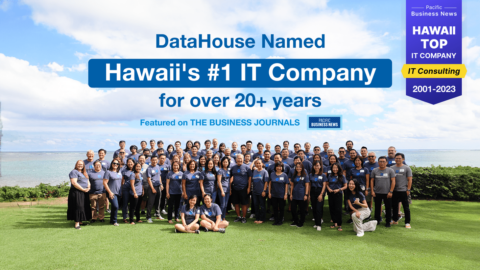Now, more than ever, the growing trend of artificial intelligence (AI) and Chatbot technology has the incredible potential to increase your revenue and transform the way you do business.
“Bots are becoming the shiny, new toy in business,” says Bradley Bishop, Software Engineer at DataHouse. “Facebook has about eleven thousand Chatbots on Messenger. Conversational commerce is projected to become a ten billion dollar industry within the next ten years!”
What in the World is a Chatbot?
Chatbots are computer-based, artificial intelligence programs that interact with users online, through apps, or any other customer service communication platform. Chatbots are powerful tools for answering routine questions and assisting individuals whenever hands-free multitasking is needed or if users need help with placing orders, basic tasks, private matters (e.g. legal advice), and even helping to improve or replace some simple 24/7 customer service tasks—especially when the company is understaffed.

DataHouse Software Engineer, Bradley Bishop, gives lecture on AI and Chatbots at a Brown Bag Series Tech Talk.
“People really enjoy Pizza Hut’s Chatbot used to take orders, for example,” explains Brad. “It remembers your previous order and you don’t have to go through the process of entering payment information all over again. It’s all about the simple flow.”
However, Brad cautions against Chatbots being used to compete with customer service. “There’s a human element that’s definitely needed in business,” explains Brad. “That’s something many businesses have failed in because they were trying to replace human personnel with Chatbots. This technology should only add a unique business value, not replace the personal touch of customer service.”
Unleashing Unlimited Potential
The intelligence of Chatbots goes far beyond answering simple questions.
“Other than just talking and understanding what we’re saying, Chatbots can simultaneously connect with multiple sources of real-time information,” Brad explains. “Chatbots have a wide range of integrations they can incorporate, like connecting with databases, social media messaging apps, and API’s utilizing cloud based tools. These all add to what kinds of information the Chatbot can deliver and applications it can be applied to, including using sentiment analysis in both visual and oral communications for various purposes.”
For example, businesses can use Chatbots as an authentication strategy. “By taking a selfie with a certain gesture or facial expression, it can not only recognize you, but it can also recognize what expressions you’re making to some degree and what sentiment it is,” Brad adds. “It’s controversial because it’s not a thumbprint or an eye scan, but it can be another way of tackling the evolution of security; not having to memorize a lot of passwords that can be easily hacked.”
The artificial intelligence (AI) of bots are not altogether new. Joseph Weizanbaum’s “Eliza” program was developed in the 1960’s to psychoanalyze people, with many believing in Eliza’s intelligence despite the creator’s insistence that it had none.
“Alan Turing, a computer scientist, mathematician, and philosopher (among other specialties) living in the early 1900’s, developed the idea of a test that has become a sort of Holy Grail for many in the field of AI,” explains Brad. “The idea of the test is that a person communicates, unable to see with whom or what they are communicating with, and are not told whether it is a human or AI. If they are talking to an AI program and they assume that it is a human, it has passed the Turing Test.”
However, having Chatbots as technological “friends” are not what AI specialists are trying to achieve.
“What we’re looking for is more of an assistant,” says Brad. “We don’t want to become Chatbots and we don’t want Chatbots or AI to become us. The intelligence of Chatbots should be utilized to chase after our goals to create a brighter, more innovative future that delivers information and help to our customers with speed and excellence, all the while increasing productivity and revenues for our companies.”












